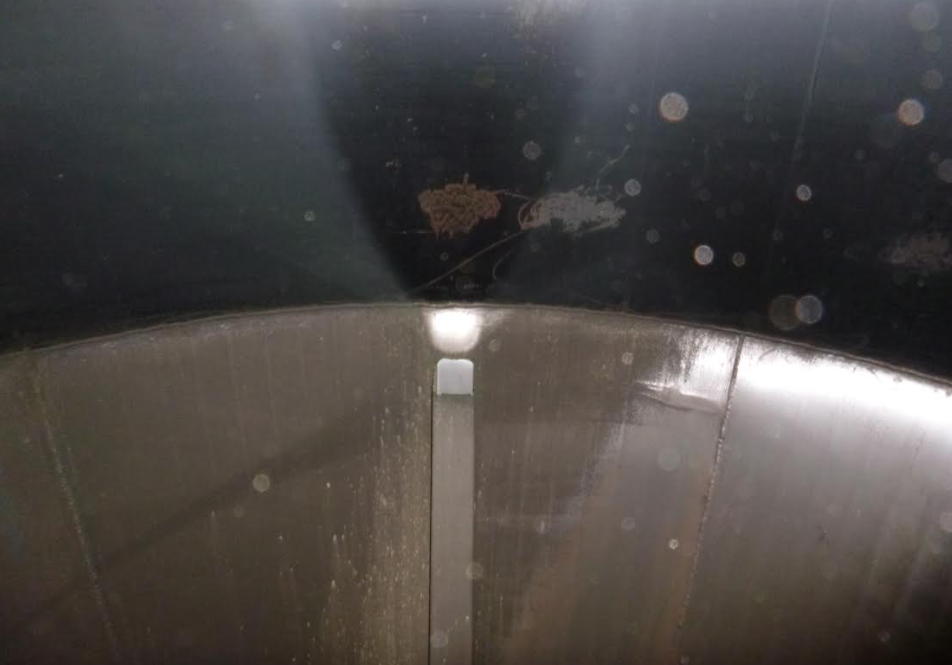5 Silo Hacks
Having inspected thousands of silos in a wide range of industries, we have seen a lot of strange things. This blog post will cover five of them, to provide you with list of common challenges to watch out for at your facility, and to not repeat them to your detriment! Some deserve a deeper dive to explore the why and the how. For these, I’ll be writing future blog posts. Stay tuned!
1: Use Caution When Adding Air Pressure
Use caution when adding air. The pressure can cause cracks!
Silos routinely use aeration pads in the bottom to assist in making material flow more easily. These pressures routinely are in the four to six pounds per square inch (psi) range. But when material plugs, or the material doesn’t flow well, facility personnel sometimes increase the air pressure to try to make the material flow better.
This increase in pressure can fluidize the entire column of material, changing how it loads the silo structure, and increasing it up to five times the original design pressure. The effect can be catastrophic, and typically is very expensive. I’ll cover this common occurrence in more detail in a future blog.
2. Call in an Expert Before Adding Reclaim Outlets
We’ve seen many silos, in industries from grain to automotive, power generation to cement, where people have added nonconcentric outlets. These take the form of truck outlet spouts on the side walls, to added spouts on existing hoppers. The reasons make sense: an owner has a new process and needs to feed it from a new outlet in the hopper, or they want to start to feed trucks directly from the side of a silo. But these added outlets can lead to asymmetric flow.
It's not a coincidence that the cracking in the silo walls is above the outlets. The asymmetric flow from using the side discharges has permanently damaged these silos.
Asymmetric flow happens in cases like this because when material is being reclaimed, a flow channel of moving material develops. In this flow channel, the pressures are lower than in the static material around it. If this flow channel intersects the silo wall, the lower pressures have a tendency to suck the wall in / create a bending or flexure of the wall. The results of this bending nearly always exceed that of the uniform pressure that the silo was originally designed for. This causes an overstress in the silo wall, leading to permanent damage.
Before any outlets are added to a silo, an experienced structural engineer (like the ones at SSI Consulting) should analyze the silo to determine if the existing silo can withstand the changes and, if necessary, design the strengthening required.
3. Avoid Using Interstice Space for Storage
The use of this interstice has caused damage to the point that all four round silos, as well as the interstice, are in need of repair, costing millions of dollars and months of downtime.
This deserves a separate post for sure, but in summary the use of interstices (the star shaped bins in between four round silos) is not free storage. When material is stored in an interstice, it exerts an outward pressure on the wall that creates a flexure / bending. This effect typically is greater than that of the uniform pressure on the round silo outward.
We’ve observed that older silos were not designed with this in mind, and typically can prematurely damage the walls of a silo group. Unfortunately, we sometimes have to recommend a reduction in capacity or complete abandonment of the interstice. This can also cause the walls to shift outward, resulting in damage to roof support beam bearings, which can lead to roof collapse.
4. Changing the Material Stored can Lead to Challenges
Silos are designed for a specific material. This material, whether it’s plastic pellets, kitty litter, coal, grain or cement, to name a few, has specific properties. Most owners know that materials have varying densities, and that a silo designed for a material with a density of 45 pounds per cubic foot (pcf) cannot be relied upon to store material with a density of 90 pcf.
But many people don’t understand that other properties, such as coefficient of lateral pressure, angles of internal friction, or friction factor of the material against the silo wall material (typically concrete or steel) also have an effect. While sometimes these properties are sufficiently similar between materials, that’s not always the case. These can vary greatly and can lead to problems if a proper analysis isn’t performed.
5. Bring in an Expert when Modifying Your Hopper / Outlet Arrangement
The above topic of adding an outlet (Hack #2) is a subset of this one. But more broadly, we’ve seen clients concerned with material not flowing evenly and adding flow retarders to discourage concentric mass flow, adding airpads, or increasing the length of airpads, adding a wear/liner plate constructed of stainless steel or other material, or facing a myriad of other changes that can affect how the material in a silo flows. These changes in flow can affect the silo structure by changing from funnel flow to mass flow, creating an asymmetric flow channel, promoting stagnant material to build up (that could spontaneously combust). Generally speaking, don’t modify your silo without consulting an experienced engineering firm to understand the possible ramifications of the proposed modifications.
This bin had interior chutes added. Note the effect - asymmetric flow and premature wear of the wall and hopper.
We hope these silo hacks help you keep your product flowing and your facilities safe. When facing any of these challenges, or other uncertainties, contact the experts at SSI. We’re here to put our expertise to work for you!
Ready to learn more?



